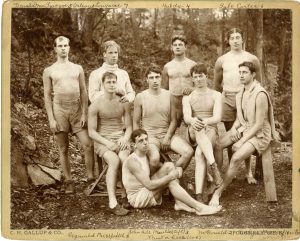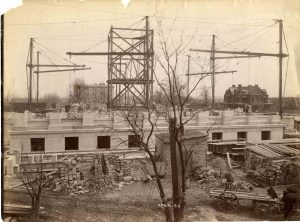The first students to reside on the Columbia campus on Morningside Heights were members of the 1895 Varsity Crew Team. Just months after acquiring the land and two years before classes even started on the new site, the crew team was granted permission to use a house on the Bloomingdale Asylum grounds as training quarters.

In the early days of athletics, the track and rowing teams relied on the Columbia College Union to raise funds from alumni to support their seasons via subscriptions. Established in 1894, the Union served as a liaison between the alumni and the student-athlete community. In January 1895, Guy Richards, CC 1887, a former crew team member, coach of the Freshman crew, and chair of the Union’s Rowing Committee, asked the Trustees’ Committee on Buildings and Grounds for the use of a house “on the new site at Cathedral Heights” at 116th Street and Amsterdam Avenue. This was back when the term Morningside Heights was not yet in use. Columbia had only taken possession of the new site a few months earlier, in October 1894, and the University would not officially move until October 1897, but the site still had the Bloomingdale Asylum buildings available for use.
The house in question was none other than the current Buell Hall, the only remaining Bloomingdale building on campus, formerly known as Macy Villa. The crew team was interested in the building since it contained 16 rooms and 6 bathrooms and was supposedly “the most luxurious building ever occupied by a crew, it having every advantage in the way of ventilation and bathing facilities.” The rowers moved in on March 20, 1895 and remained until June. Staying at the house were the 8 rowers of the crew, 4 substitutes, a coxswain, 2 waiters and a trainer. The captain of the team, John Hill Prentice CC 1897, was responsible for discipline. According to the Trustee minutes, no card playing, gambling of any sort, or smoking were allowed on the premises. By staying at the Asylum, team members could easily walk from their new home to the Bloomingdale Boat House, on the Hudson at 103rd Street. And the season was a great success: Columbia defeated Cornell and the University of Pennsylvania at the Triangular Race in Poughkeepsie, NY in June 1895.

The following year, in January 1896, the Rowing Committee again requested to use the same training quarters for the spring season. President Seth Low notified the Union that the rowers would not be permitted to use the house unless the bills of the previous spring were paid and a satisfactory guarantee was furnished that the coming year would be paid promptly. (Those alumni subscriptions did not always come through on time.) By the time the crew team agreed to those terms and moved in, in April 1896, the site was no longer an empty asylum, but an active construction site. From their training quarters, the team would have seen the construction of the Library (now Low), Schermerhorn Hall and the Physics Buildings (now Fayerweather Hall). Unfortunately, even with 7 of the 8 rowers from the 1895 team returning, the season did not end well at Poughkeepsie.
It would be nearly 10 years before any other students would reside on campus, when Hartley and Livingston (now Wallach) Halls opened as Columbia’s first dormitories in 1905.